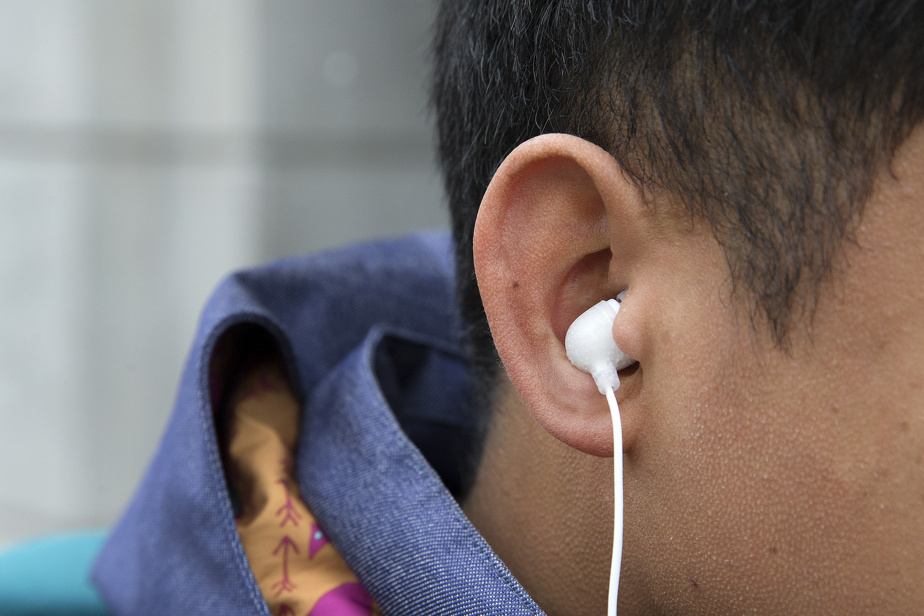Putting on your headphones and listening to something helps pass the time when you have to wait. Waiting in line at airport security? Not so bad if you can watch a gardening tutorial. A 12 hour flight? No problem if you have downloaded your entire favorite series on your mobile.
The ubiquity of headphones began in 1979 with the Sony Walkman. Hailed as a modern marvel or denounced as a vector of individualist incivility, they are everywhere. As we head into the holidays, here are some suggestions for their use, especially in airports and airplanes, where we share limited space with many other human beings.
When should you remove your headphones? Airport etiquette specialists give us their opinion.
Stay in touch with reality

PHOTO CHARDAY PENN, GETTY IMAGES
Headphones can cause you to miss crucial information.
Headphones are a godsend to escape the frenetic atmosphere of the airport: crying babies, loud chatterboxes, workers renovating, coughing colds. But excluding yourself 100% from the sound environment can cause big problems.
“You risk missing crucial information and seriously jeopardizing your trip,” says Jonnie Lane, a flight attendant with Delta Air Lines for 16 years.
If passengers are told about a change of boarding gate or an emergency, you’re done. If you’re asked on the intercom, you could miss the flight, delay boarding and make things difficult for staff. “That’s why we ask people to pay attention if they’re wearing their headphones,” says M.me Lane.
Take off your headphones with the staff
When faced with a gate agent, a Starbucks cashier or a flight attendant, the level of courtesy is to give them your attention, says Nick Leighton, who hosts Were You Raised By Wolves? (Were you raised by wolves?), podcast on politeness in the 21st centurye century. Not removing your headphones when someone is talking to you is a cardinal sin.
“It’s important to be aware of the energy we send to others,” says David Coggins, author of Men and Manners (Men and Courtesy), an American best-selling book. “With headphones, you put yourself in your little bubble in noise cancellation mode, but you ignore everyone around,” he adds. “We still want to get in touch with our fellow human beings. »
When approaching someone, or vice versa, “take off your headphones and sunglasses and put down the cell phone,” suggests Mr. Leighton. Same thing by presenting your passport and boarding pass, greeting the flight attendant or at least giving a little nod to your row neighbors.
“When someone sits next to me on the plane, I look at them, smile and say hello,” says Coggins. “But then I look away. Especially nothing that encourages a terrible conversation like: “So where are you from?” »
The minimal courtesy of removing your headphones, at the beginning, is a way of acquiescing that you will be strung out like firewood for several hours and “a signal that I want this to go well,” summarizes Mr. Coggins.
Reasonable ear comfort
With a headset, it is better to put it around your neck if you are talking with someone. With earbuds, removing just one is enough to show your consideration to the interlocutor.
“In the queue, when I get to the counter, I usually take off an earpiece so the person knows they have my attention and I say thank you,” adds Mr. Coggins.
Mme Lane, the flight attendant, agrees, leaving just one on her shoulder is enough, that’s what she does herself when she flies as a passenger. » It would be nice to remove both, but you know, removing one is okay. It’s correct. »
Keep your calls and videos to yourself
What is never acceptable is listening to anything on speaker. Headphones are required if you are called, if you take your messages, if you watch a video or play a video game on your phone.
If wearing your headphones at the wrong time is rude to the few people you’re ignoring, force your meeting Zoom to your neighbors is “a crime against everyone,” Mr. Coggins said.
The recent trend of taking calls on speakerphone in public is particularly abhorrent. “There are a lot of people who like to talk on the phone like it’s a walkie-talkie,” laments Mr. Coggins.
Do everyone a favor and put your phone to your ear, the old fashioned way, or put in your headphones.
Pay attention to safety instructions

CREATIVE PHOTO CREDIT, GETTY IMAGES
Even if it bothers you, listen to the safety instructions.
Even if you’ve heard the story a thousand times, take off your headphones when the flight attendant stands at the end of the aisle to demonstrate the safety instructions before takeoff.
“It’s a question of courtesy, but also of safety,” says Mr. Leighton, who reminds us that not all planes are made the same: “Evacuating a plane in 90 seconds or less is a real job. team. »
It’s a small gesture, but the crew appreciates it: “It ends up weighing on me when I do it several times in the same day and I’m repeatedly ignored,” admits Mme Lane. It’s frustrating. I am here above all for their safety. »
Flight attendants are responsible for helping you in an emergency; the safety instructions are designed so that you can help yourself.
Besides, “you don’t want to find yourself in a situation where you’ve completely ignored them – not even a glance – and then you need help during the flight,” says Jules Hirst, co-author of the book. Power of Civility (The power of civility).
Conversely, you should know that some autistic people use headphones to minimize sensory triggers and keep them on all the time to better tolerate noisy and crowded places like airports and planes.
Take a moment before judging: we don’t know everything about people.
This article was originally published in the Washington Post.
Read the original article on the website Washington Post (in English, subscription required)
